Low-Alcohol Beverages Market Size 2025-2029
The low-alcohol beverages market size is valued to increase by USD 435.2 million, at a CAGR of 5% from 2024 to 2029. Increasing health consciousness among consumers will drive the low-alcohol beverages market.
Market Insights
- Europe dominated the market and accounted for a 43% growth during the 2025-2029.
- By Distribution Channel - Off-trade segment was valued at USD 814.20 million in 2023
- By Product - Low alcohol beer segment accounted for the largest market revenue share in 2023
Market Size & Forecast
- Market Opportunities: USD 44.29 million
- Market Future Opportunities 2024: USD 435.20 million
- CAGR from 2024 to 2029 : 5%
Market Summary
- The market is experiencing significant growth driven by increasing health consciousness among consumers. This trend is particularly noticeable in the beer industry, where the demand for gluten-free and low-calorie options is on the rise. However, this market segment also faces challenges, such as the availability of counterfeit products that can undermine brand reputation and consumer trust. Supply chain optimization is a critical concern for businesses in this sector. Ensuring the timely delivery of high-quality, authentic products is essential to maintaining customer satisfaction and loyalty. Compliance with regulations related to alcohol content and labeling is another operational challenge that requires careful attention.
- For instance, a beverage manufacturer may invest in advanced technologies, such as real-time monitoring systems and automated labeling machines, to streamline production processes and ensure regulatory compliance. By optimizing their supply chain and maintaining product quality, companies can differentiate themselves in a competitive market and build a strong brand reputation. In conclusion, the market is poised for continued growth, driven by health-conscious consumers and the increasing popularity of gluten-free and low-calorie options. However, businesses must address challenges such as counterfeit products, supply chain optimization, and regulatory compliance to succeed in this dynamic market.
What will be the size of the Low-Alcohol Beverages Market during the forecast period?
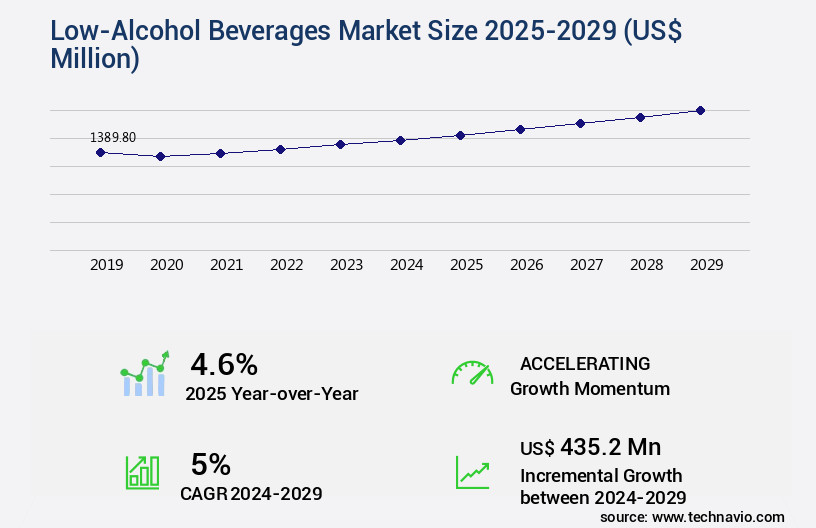
Get Key Insights on Market Forecast (PDF) Request Free Sample
- The market continues to evolve, driven by consumer preferences for healthier and more socially responsible drinking options. Headspace analysis and chromatography techniques play a crucial role in taste receptors research, enabling brands to develop beverages with optimal flavor profiles. In the realm of production, distillation methods such as vacuum distillation and spinning cone column are increasingly adopted for alcohol removal. Oenological practices and sensory profiling are essential components of brand strategy, ensuring a high-quality product that resonates with consumers. Optimizing the supply chain through reverse osmosis, membrane filtration, and bottling lines is a key focus for companies seeking cost reduction.
- Malting techniques and packaging materials are also under scrutiny as they impact both production efficiency and consumer perception. The distribution network is another critical area of concern, with companies exploring new channels to reach consumers. Process optimization and quality control are essential to maintaining market competitiveness. Flavor chemistry and aroma compounds are at the forefront of innovation, as companies strive to create unique and appealing low-alcohol beverage offerings. By adopting these advanced techniques and technologies, businesses can effectively cater to the evolving consumer demand while ensuring operational efficiency and cost savings.
Unpacking the Low-Alcohol Beverages Market Landscape
The market represents a significant opportunity for businesses seeking to cater to health-conscious consumers and those desiring to reduce their alcohol intake. According to recent studies, the global low-alcohol beer market is projected to reach a 13% share of the total beer market by 2025, up from 10% in 2020. In the non-alcoholic wine segment, sales have grown by 15% annually over the past five years, outpacing the overall wine market growth rate.
Shelf life extension is a crucial factor in the low-alcohol beverages industry. Quality assurance systems and product stability testing ensure that beverages maintain their sensory attributes and flavor profiles throughout the supply chain. Innovations in packaging, such as airtight containers and modified atmosphere packaging, contribute to extended shelf life and reduced waste.
Consumer acceptance testing and sensory evaluation methods are essential for new product development, ensuring that low-alcohol beverages meet the taste preferences of the target audience. Ingredient sourcing strategies and flavor enhancement techniques play a vital role in creating unique product offerings and differentiating brands.
Beverage processing technology, including dealcoholization membranes and fermentation process optimization, enable the production of high-quality, low-alcohol beverages while minimizing production costs. Regulatory compliance issues are addressed through rigorous quality control parameters and adherence to industry standards.
Brand positioning and distribution channels are critical factors in the success of low-alcohol beverages. Effective sales performance metrics and marketing strategies can help businesses capitalize on the growing demand for these products.
Key Market Drivers Fueling Growth
Consumers' growing health consciousness serves as the primary catalyst for market expansion.
- The market is witnessing significant growth due to the increasing health consciousness among consumers. These beverages are marketed as healthier alternatives to conventional alcoholic drinks, attracting consumers who are health-conscious but not willing to give up alcohol entirely. According to recent studies, globally, over 50% of consumers prefer healthy and nutritious food and beverages. Traditional alcoholic beverages, such as high-alcohol beer, are linked to various health concerns, including anemia, cancer, cardiovascular diseases, depression, high blood pressure, and nerve damage.
- As a result, consumers are transitioning to low-alcohol beverages, which offer a safer and healthier option. Approximately 25% of consumers in Europe and North America have already switched to low-alcohol beverages, and this trend is expected to continue. Additionally, the production of low-alcohol beverages consumes 12% less energy compared to traditional alcoholic beverages, making them a more sustainable choice for health-conscious consumers.
Prevailing Industry Trends & Opportunities
The trend in the beer market is shifting towards an increased demand for gluten-free and low-calorie beer options.
- The market is experiencing significant growth due to evolving consumer preferences and trends. The increasing demand for gluten-free and low-calorie options is a major driver, with the global gluten-free product market expanding at a steady pace. This trend is particularly notable in the beer sector, where health-conscious consumers seek alternatives. For instance, the number of people with celiac disease in the US is growing rapidly, and many remain undiagnosed, fueling the demand for gluten-free beer. Another key trend is the focus on low-calorie beverages, as people prioritize health and wellness.
- These shifts in consumer behavior are transforming the market landscape and creating new opportunities for innovation. For businesses, this means adapting to meet the changing demands of consumers and capitalizing on the growing market for low-alcohol beverages.
Significant Market Challenges
The proliferation of counterfeit products poses a significant challenge to the industry's growth trajectory, requiring heightened vigilance and stringent measures to safeguard brand reputation and consumer trust.
- The market is experiencing significant evolution, driven by increasing consumer preference for healthier options and the expanding alcoholic beverages sector. However, this market faces challenges, including the proliferation of counterfeit products. Every year, authorities in various countries seize counterfeit food and beverage items, including low-alcohol beverages. These counterfeit products, often manufactured in developing regions, are made with low-quality raw materials and can pose health risks. The penetration of e-commerce platforms has further facilitated the distribution, sales, and reach of these illicit products.
- Despite these challenges, the market continues to grow, with companies investing in innovation and product development to meet consumer demands for healthier, lower-alcohol alternatives. For instance, a leading beverage company reported a 15% increase in sales of its low-alcohol beer line, while another reported a 20% reduction in production costs through the implementation of advanced brewing technologies.
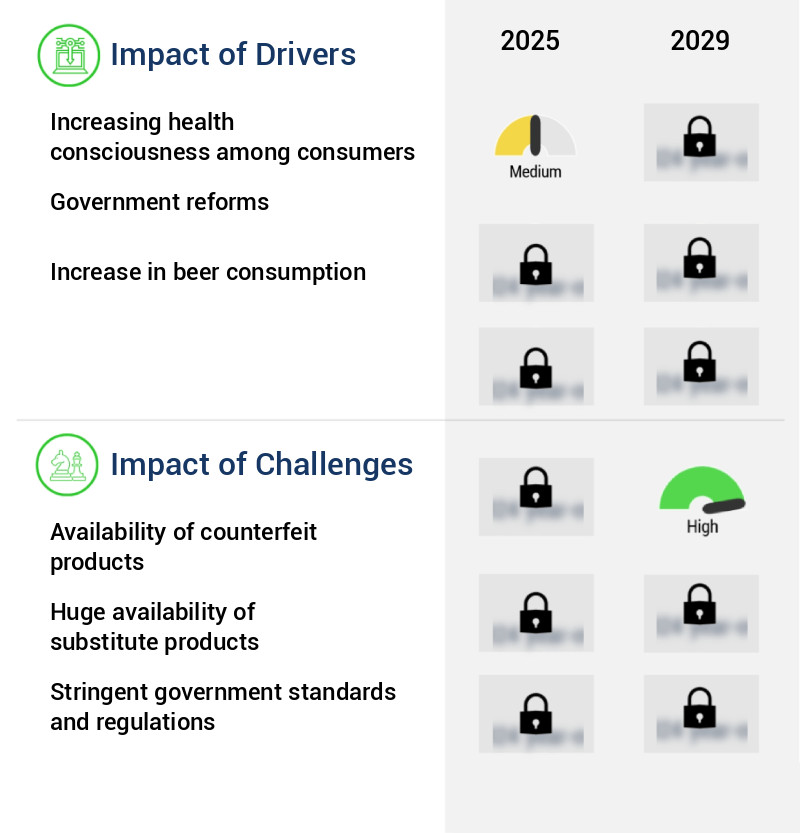
In-Depth Market Segmentation: Low-Alcohol Beverages Market
The low-alcohol beverages industry research report provides comprehensive data (region-wise segment analysis), with forecasts and estimates in "USD million" for the period 2025-2029, as well as historical data from 2019-2023 for the following segments.
- Distribution Channel
- Product
- Low alcohol beer
- Low alcohol wine
- Low alcohol RTD
- Low alcohol cider
- Low alcohol spirits
- Packaging
- Geography
- North America
- Europe
- France
- Germany
- Italy
- Spain
- UK
- APAC
- Rest of World (ROW)
By Distribution Channel Insights
The off-trade segment is estimated to witness significant growth during the forecast period.
The market is witnessing continuous evolution, driven by consumer preferences for healthier and more sustainable options. This shift is reflected in the growing significance of the off-trade segment, which now accounts for a substantial market share. Supermarkets, hypermarkets, individual retailers, and online platforms are the primary off-trade distribution channels for low-alcohol beverages. These channels provide consumers with a diverse range of options, enabling them to choose according to their taste preferences and budget. Major retailers like Tesco Plc, Carrefour SA, and Target Brands Inc. Have dedicated sections for low-alcohol beverages, offering a wide array of brands. The sales of these beverages through off-trade channels are projected to expand further due to the increasing number of manufacturers entering the market.
Innovations in flavor enhancement techniques, ingredient sourcing strategies, and production cost optimization are key drivers of new product development. Regulatory compliance, product stability testing, and sensory evaluation methods are essential components of the quality assurance systems in place. Beverage processing technology advancements, such as dealcoholization membranes and alcohol reduction techniques, ensure consistent alcohol content measurement. These factors contribute to the market's growth and product differentiation.
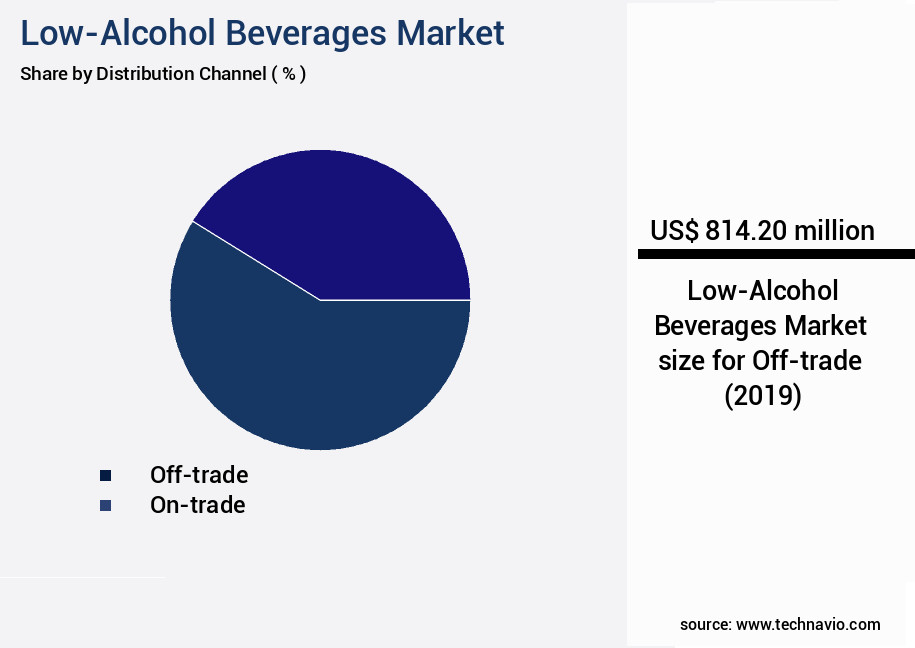
Request Free Sample
The Off-trade segment was valued at USD 814.20 million in 2019 and showed a gradual increase during the forecast period.
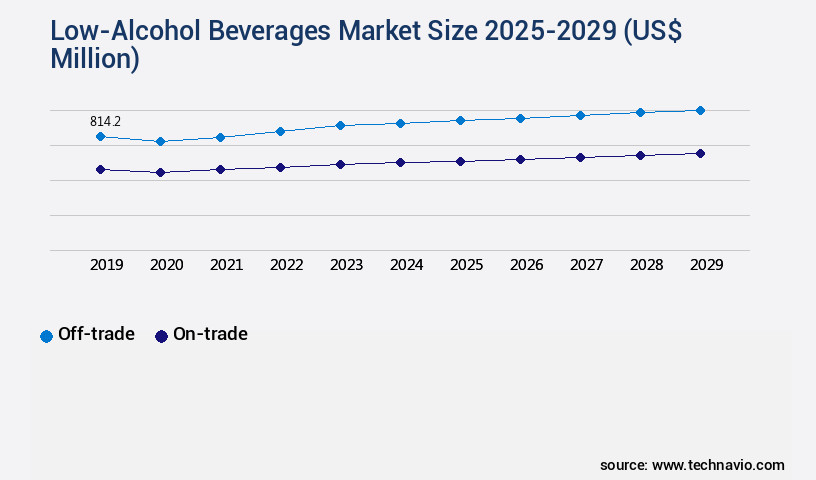
Request Free Sample
Regional Analysis
Europe is estimated to contribute 43% to the growth of the global market during the forecast period.Technavio’s analysts have elaborately explained the regional trends and drivers that shape the market during the forecast period.
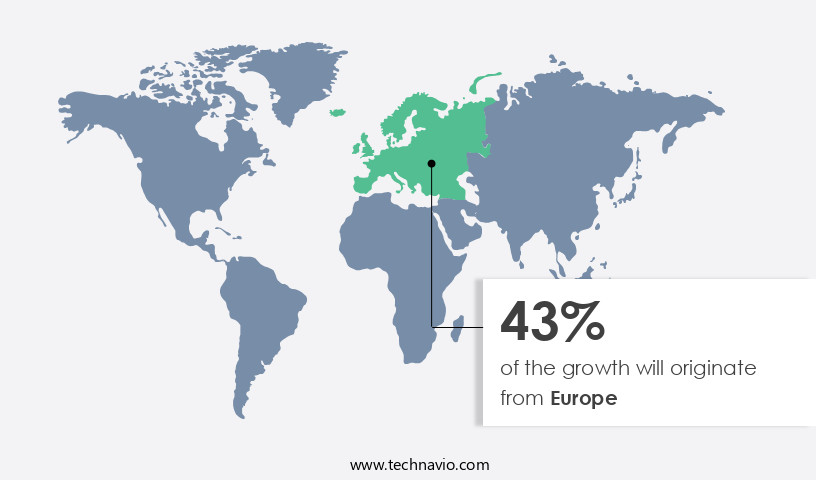
See How Low-Alcohol Beverages Market Demand is Rising in Europe Request Free Sample
The European the market is experiencing robust growth, driven by the introduction of a diverse range of products in countries like Germany, Spain, and the UK. This expansion is fueled by the region's high living standards and the strong brand value of these offerings. Companies in Europe cater to various consumer segments with their low-alcohol beverages, available in numerous variants and price points. To enhance their market presence and profitability, these businesses invest in research and development, as well as marketing efforts.
For instance, the number of low-alcohol beer launches in Europe increased by 10% in 2020 compared to the previous year. Furthermore, the market's focus on cost reduction and operational efficiency gains, such as optimizing production processes, contributes to its ongoing development.
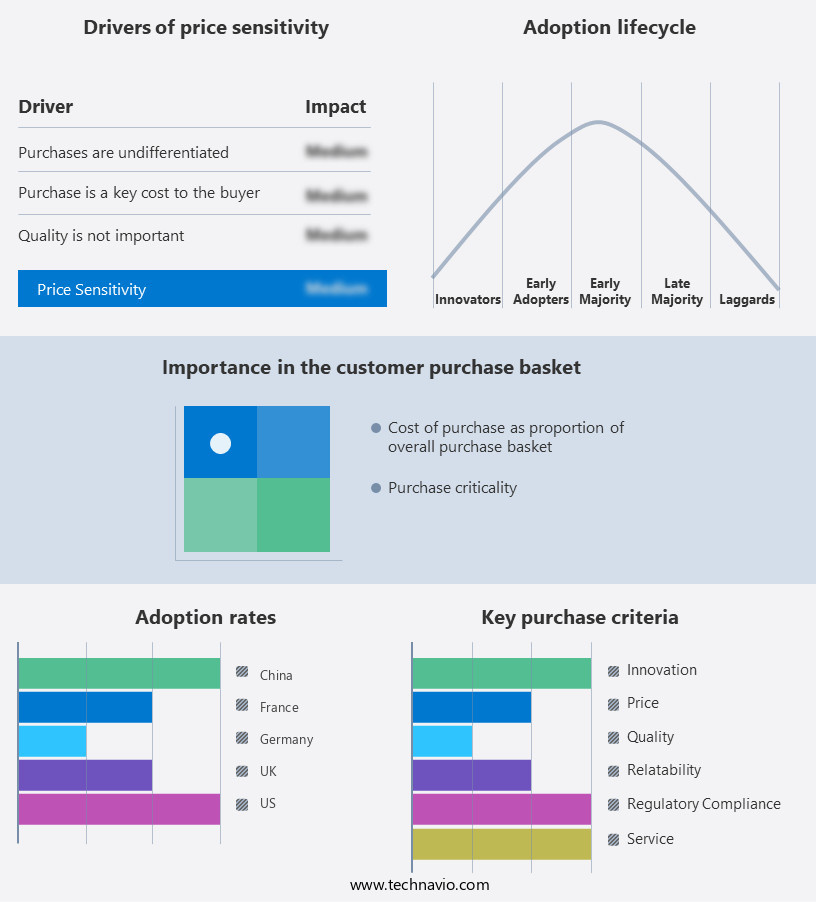
Customer Landscape of Low-Alcohol Beverages Industry
Competitive Intelligence by Technavio Analysis: Leading Players in the Low-Alcohol Beverages Market
Companies are implementing various strategies, such as strategic alliances, low-alcohol beverages market forecast, partnerships, mergers and acquisitions, geographical expansion, and product/service launches, to enhance their presence in the industry.
Accolade Wines Australia Ltd. - This company specializes in low alcohol beverages, including Thomas Hardy, Moscato, and Crimson Cab. These offerings cater to consumers seeking reduced alcohol content without compromising taste. The beverages' production and quality reflect the company's commitment to innovation and consumer satisfaction.
The industry research and growth report includes detailed analyses of the competitive landscape of the market and information about key companies, including:
- Accolade Wines Australia Ltd.
- Allagash Brewing Co.
- Anheuser Busch InBev SA NV
- Asahi Group Holdings Ltd.
- Bacardi and Co. Ltd.
- Beam Suntory Inc.
- Carlsberg Breweries AS
- CODYs Drinks International GmbH
- Constellation Brands Inc.
- Curious Elixirs
- Diageo PLC
- Heineken NV
- Kirin Holdings Co. Ltd.
- Metabrand Corp.
- Molson Coors Beverage Co.
- New Belgium Brewing Co. Inc.
- Olvi Plc
- Royal Unibrew AS
- Sapporo Holdings Ltd.
- The Boston Beer Co. Inc.
Qualitative and quantitative analysis of companies has been conducted to help clients understand the wider business environment as well as the strengths and weaknesses of key industry players. Data is qualitatively analyzed to categorize companies as pure play, category-focused, industry-focused, and diversified; it is quantitatively analyzed to categorize companies as dominant, leading, strong, tentative, and weak.
Recent Development and News in Low-Alcohol Beverages Market
- In January 2024, Heineken, a global brewer, launched its new low-alcohol beer brand, "Heineken 0.0," in the United States. This expansion marked the brand's entry into the growing low-alcohol beverage market in the country (Heineken Press Release, 2024).
- In March 2024, Diageo, a leading spirits company, announced a strategic partnership with Seedlip, a non-alcoholic spirits producer. The collaboration aimed to develop new low-alcohol and alcohol-free beverage offerings, strengthening Diageo's presence in the low-alcohol beverage sector (Diageo Press Release, 2024).
- In May 2024, Constellation Brands, an international producer and marketer of beer, wine, and spirits, completed the acquisition of High End Beverage Company, a leading producer of low-alcohol and non-alcoholic beverages. The acquisition expanded Constellation Brands' portfolio and increased its market share in the low-alcohol beverage market (Constellation Brands Press Release, 2024).
- In August 2024, Anheuser-Busch InBev, the world's largest brewer, received regulatory approval from the Alcohol and Tobacco Tax and Trade Bureau (TTB) to launch its new low-alcohol beer, "Bud Light Next," in the United States. The approval marked the beginning of sales for the new product, which aimed to cater to the growing demand for low-alcohol beverages (Anheuser-Busch InBev Press Release, 2024).
Dive into Technavio’s robust research methodology, blending expert interviews, extensive data synthesis, and validated models for unparalleled Low-Alcohol Beverages Market insights. See full methodology.
|
Market Scope
|
|
Report Coverage
|
Details
|
|
Page number
|
228
|
|
Base year
|
2024
|
|
Historic period
|
2019-2023 |
|
Forecast period
|
2025-2029
|
|
Growth momentum & CAGR
|
Accelerate at a CAGR of 5%
|
|
Market growth 2025-2029
|
USD 435.2 million
|
|
Market structure
|
Fragmented
|
|
YoY growth 2024-2025(%)
|
4.6
|
|
Key countries
|
US, UK, Germany, France, China, Italy, India, Spain, Canada, and Japan
|
|
Competitive landscape
|
Leading Companies, Market Positioning of Companies, Competitive Strategies, and Industry Risks
|
Request Free Sample
Why Choose Technavio for Low-Alcohol Beverages Market Insights?
"Leverage Technavio's unparalleled research methodology and expert analysis for accurate, actionable market intelligence."
The market has experienced significant growth in recent years, with consumers increasingly seeking healthier and more moderate drinking options. Dealcoholization, a process used to remove alcohol from beverages while preserving their aroma compounds, plays a crucial role in this market. Sensory evaluation of low-alcohol wines and beers is essential to ensure the optimal balance between flavor and alcohol content.
To produce high-quality low-alcohol beverages, it's important to optimize fermentation parameters and implement quality control measures during alcohol removal. Process engineering in alcohol production and alcohol reduction techniques in spirits production are key areas of focus for companies seeking to develop novel low-alcohol products.
The effect of processing on flavor profiles is a critical consideration in low-alcohol beverage production. Aroma preservation methods, such as vacuum distillation and membrane filtration, are used to maintain the aroma compounds that contribute to the unique taste and smell of these beverages.
Consumer acceptance of low-alcohol beverages is a significant factor in the market's growth. Sensory attribute analysis of dealcoholized beer and wine can help manufacturers understand consumer preferences and tailor their product development strategies accordingly. The impact of packaging on shelf life is also a key consideration, with companies investing in advanced packaging technologies to extend the life of their low-alcohol offerings.
The competition in the market is fierce, with companies constantly seeking to differentiate themselves through new product development and innovation. For example, some manufacturers have focused on developing low-alcohol spirits using techniques such as vacuum distillation and reverse osmosis. The sensory evaluation methods for low-alcohol beverages, including descriptive analysis and consumer testing, are essential to ensure that these new products meet consumer expectations.
Cost optimization is a critical business function in the market. Manufacturers must balance the cost of dealcoholization and other production processes with the need to maintain product quality and meet consumer demand. For instance, some companies have explored the use of alternative sweeteners and flavorings to reduce the overall cost of production while still delivering a high-quality product. Overall, the market is a dynamic and evolving space, with companies continually seeking to innovate and meet the changing preferences of health-conscious consumers.
What are the Key Data Covered in this Low-Alcohol Beverages Market Research and Growth Report?
-
What is the expected growth of the Low-Alcohol Beverages Market between 2025 and 2029?
-
What segmentation does the market report cover?
-
The report is segmented by Distribution Channel (Off-trade and On-trade), Product (Low alcohol beer, Low alcohol wine, Low alcohol RTD, Low alcohol cider, and Low alcohol spirits), Packaging (Bottles, Cans, and Tetra-packs), and Geography (Europe, North America, APAC, South America, and Middle East and Africa)
-
Which regions are analyzed in the report?
-
Europe, North America, APAC, South America, and Middle East and Africa
-
What are the key growth drivers and market challenges?
-
Who are the major players in the Low-Alcohol Beverages Market?
-
Accolade Wines Australia Ltd., Allagash Brewing Co., Anheuser Busch InBev SA NV, Asahi Group Holdings Ltd., Bacardi and Co. Ltd., Beam Suntory Inc., Carlsberg Breweries AS, CODYs Drinks International GmbH, Constellation Brands Inc., Curious Elixirs, Diageo PLC, Heineken NV, Kirin Holdings Co. Ltd., Metabrand Corp., Molson Coors Beverage Co., New Belgium Brewing Co. Inc., Olvi Plc, Royal Unibrew AS, Sapporo Holdings Ltd., and The Boston Beer Co. Inc.
We can help! Our analysts can customize this low-alcohol beverages market research report to meet your requirements.
Get in touch
1 Executive Summary
- 1.1 Market overview
- Executive Summary - Chart on Market Overview
- Executive Summary - Data Table on Market Overview
- Executive Summary - Chart on Global Market Characteristics
- Executive Summary - Chart on Market by Geography
- Executive Summary - Chart on Market Segmentation by Distribution Channel
- Executive Summary - Chart on Market Segmentation by Product
- Executive Summary - Chart on Market Segmentation by Packaging
- Executive Summary - Chart on Incremental Growth
- Executive Summary - Data Table on Incremental Growth
- Executive Summary - Chart on Company Market Positioning
2 Technavio Analysis
- 2.1 Analysis of price sensitivity, lifecycle, customer purchase basket, adoption rates, and purchase criteria
- Analysis of price sensitivity, lifecycle, customer purchase basket, adoption rates, and purchase criteria
- 2.2 Criticality of inputs and Factors of differentiation
- Overview on criticality of inputs and factors of differentiation
- 2.3 Factors of disruption
- Overview on factors of disruption
- 2.4 Impact of drivers and challenges
- Impact of drivers and challenges in 2024 and 2029
3 Market Landscape
- 3.1 Market ecosystem
- Parent Market
- Data Table on - Parent Market
- 3.2 Market characteristics
- Market characteristics analysis
4 Market Sizing
- 4.1 Market definition
- Offerings of companies included in the market definition
- 4.2 Market segment analysis
- 4.4 Market outlook: Forecast for 2024-2029
- Chart on Global - Market size and forecast 2024-2029 ($ million)
- Data Table on Global - Market size and forecast 2024-2029 ($ million)
- Chart on Global Market: Year-over-year growth 2024-2029 (%)
- Data Table on Global Market: Year-over-year growth 2024-2029 (%)
5 Historic Market Size
- 5.1 Global Low-Alcohol Beverages Market 2019 - 2023
- Historic Market Size - Data Table on Global Low-Alcohol Beverages Market 2019 - 2023 ($ million)
- 5.2 Distribution Channel segment analysis 2019 - 2023
- Historic Market Size - Distribution Channel Segment 2019 - 2023 ($ million)
- 5.3 Product segment analysis 2019 - 2023
- Historic Market Size - Product Segment 2019 - 2023 ($ million)
- 5.4 Packaging segment analysis 2019 - 2023
- Historic Market Size - Packaging Segment 2019 - 2023 ($ million)
- 5.5 Geography segment analysis 2019 - 2023
- Historic Market Size - Geography Segment 2019 - 2023 ($ million)
- 5.6 Country segment analysis 2019 - 2023
- Historic Market Size - Country Segment 2019 - 2023 ($ million)
6 Qualitative Analysis
- 6.1 Impact of AI in the global low-alcohol beverages market
7 Five Forces Analysis
- 7.1 Five forces summary
- Five forces analysis - Comparison between 2024 and 2029
- 7.2 Bargaining power of buyers
- Bargaining power of buyers - Impact of key factors 2024 and 2029
- 7.3 Bargaining power of suppliers
- Bargaining power of suppliers - Impact of key factors in 2024 and 2029
- 7.4 Threat of new entrants
- Threat of new entrants - Impact of key factors in 2024 and 2029
- 7.5 Threat of substitutes
- Threat of substitutes - Impact of key factors in 2024 and 2029
- 7.6 Threat of rivalry
- Threat of rivalry - Impact of key factors in 2024 and 2029
- 7.7 Market condition
- Chart on Market condition - Five forces 2024 and 2029
8 Market Segmentation by Distribution Channel
- 8.1 Market segments
- Chart on Distribution Channel - Market share 2024-2029 (%)
- Data Table on Distribution Channel - Market share 2024-2029 (%)
- 8.2 Comparison by Distribution Channel
- Chart on Comparison by Distribution Channel
- Data Table on Comparison by Distribution Channel
- 8.3 Off-trade - Market size and forecast 2024-2029
- Chart on Off-trade - Market size and forecast 2024-2029 ($ million)
- Data Table on Off-trade - Market size and forecast 2024-2029 ($ million)
- Chart on Off-trade - Year-over-year growth 2024-2029 (%)
- Data Table on Off-trade - Year-over-year growth 2024-2029 (%)
- 8.4 On-trade - Market size and forecast 2024-2029
- Chart on On-trade - Market size and forecast 2024-2029 ($ million)
- Data Table on On-trade - Market size and forecast 2024-2029 ($ million)
- Chart on On-trade - Year-over-year growth 2024-2029 (%)
- Data Table on On-trade - Year-over-year growth 2024-2029 (%)
- 8.5 Market opportunity by Distribution Channel
- Market opportunity by Distribution Channel ($ million)
- Data Table on Market opportunity by Distribution Channel ($ million)
9 Market Segmentation by Product
- 9.1 Market segments
- Chart on Product - Market share 2024-2029 (%)
- Data Table on Product - Market share 2024-2029 (%)
- 9.2 Comparison by Product
- Chart on Comparison by Product
- Data Table on Comparison by Product
- 9.3 Low alcohol beer - Market size and forecast 2024-2029
- Chart on Low alcohol beer - Market size and forecast 2024-2029 ($ million)
- Data Table on Low alcohol beer - Market size and forecast 2024-2029 ($ million)
- Chart on Low alcohol beer - Year-over-year growth 2024-2029 (%)
- Data Table on Low alcohol beer - Year-over-year growth 2024-2029 (%)
- 9.4 Low alcohol wine - Market size and forecast 2024-2029
- Chart on Low alcohol wine - Market size and forecast 2024-2029 ($ million)
- Data Table on Low alcohol wine - Market size and forecast 2024-2029 ($ million)
- Chart on Low alcohol wine - Year-over-year growth 2024-2029 (%)
- Data Table on Low alcohol wine - Year-over-year growth 2024-2029 (%)
- 9.5 Low alcohol RTD - Market size and forecast 2024-2029
- Chart on Low alcohol RTD - Market size and forecast 2024-2029 ($ million)
- Data Table on Low alcohol RTD - Market size and forecast 2024-2029 ($ million)
- Chart on Low alcohol RTD - Year-over-year growth 2024-2029 (%)
- Data Table on Low alcohol RTD - Year-over-year growth 2024-2029 (%)
- 9.6 Low alcohol cider - Market size and forecast 2024-2029
- Chart on Low alcohol cider - Market size and forecast 2024-2029 ($ million)
- Data Table on Low alcohol cider - Market size and forecast 2024-2029 ($ million)
- Chart on Low alcohol cider - Year-over-year growth 2024-2029 (%)
- Data Table on Low alcohol cider - Year-over-year growth 2024-2029 (%)
- 9.7 Low alcohol spirits - Market size and forecast 2024-2029
- Chart on Low alcohol spirits - Market size and forecast 2024-2029 ($ million)
- Data Table on Low alcohol spirits - Market size and forecast 2024-2029 ($ million)
- Chart on Low alcohol spirits - Year-over-year growth 2024-2029 (%)
- Data Table on Low alcohol spirits - Year-over-year growth 2024-2029 (%)
- 9.8 Market opportunity by Product
- Market opportunity by Product ($ million)
- Data Table on Market opportunity by Product ($ million)
10 Market Segmentation by Packaging
- 10.1 Market segments
- Chart on Packaging - Market share 2024-2029 (%)
- Data Table on Packaging - Market share 2024-2029 (%)
- 10.2 Comparison by Packaging
- Chart on Comparison by Packaging
- Data Table on Comparison by Packaging
- 10.3 Bottles - Market size and forecast 2024-2029
- Chart on Bottles - Market size and forecast 2024-2029 ($ million)
- Data Table on Bottles - Market size and forecast 2024-2029 ($ million)
- Chart on Bottles - Year-over-year growth 2024-2029 (%)
- Data Table on Bottles - Year-over-year growth 2024-2029 (%)
- 10.4 Cans - Market size and forecast 2024-2029
- Chart on Cans - Market size and forecast 2024-2029 ($ million)
- Data Table on Cans - Market size and forecast 2024-2029 ($ million)
- Chart on Cans - Year-over-year growth 2024-2029 (%)
- Data Table on Cans - Year-over-year growth 2024-2029 (%)
- 10.5 Tetra-packs - Market size and forecast 2024-2029
- Chart on Tetra-packs - Market size and forecast 2024-2029 ($ million)
- Data Table on Tetra-packs - Market size and forecast 2024-2029 ($ million)
- Chart on Tetra-packs - Year-over-year growth 2024-2029 (%)
- Data Table on Tetra-packs - Year-over-year growth 2024-2029 (%)
- 10.6 Market opportunity by Packaging
- Market opportunity by Packaging ($ million)
- Data Table on Market opportunity by Packaging ($ million)
11 Customer Landscape
- 11.1 Customer landscape overview
- Analysis of price sensitivity, lifecycle, customer purchase basket, adoption rates, and purchase criteria
12 Geographic Landscape
- 12.1 Geographic segmentation
- Chart on Market share by geography 2024-2029 (%)
- Data Table on Market share by geography 2024-2029 (%)
- 12.2 Geographic comparison
- Chart on Geographic comparison
- Data Table on Geographic comparison
- 12.3 Europe - Market size and forecast 2024-2029
- Chart on Europe - Market size and forecast 2024-2029 ($ million)
- Data Table on Europe - Market size and forecast 2024-2029 ($ million)
- Chart on Europe - Year-over-year growth 2024-2029 (%)
- Data Table on Europe - Year-over-year growth 2024-2029 (%)
- 12.4 North America - Market size and forecast 2024-2029
- Chart on North America - Market size and forecast 2024-2029 ($ million)
- Data Table on North America - Market size and forecast 2024-2029 ($ million)
- Chart on North America - Year-over-year growth 2024-2029 (%)
- Data Table on North America - Year-over-year growth 2024-2029 (%)
- 12.5 APAC - Market size and forecast 2024-2029
- Chart on APAC - Market size and forecast 2024-2029 ($ million)
- Data Table on APAC - Market size and forecast 2024-2029 ($ million)
- Chart on APAC - Year-over-year growth 2024-2029 (%)
- Data Table on APAC - Year-over-year growth 2024-2029 (%)
- 12.6 South America - Market size and forecast 2024-2029
- Chart on South America - Market size and forecast 2024-2029 ($ million)
- Data Table on South America - Market size and forecast 2024-2029 ($ million)
- Chart on South America - Year-over-year growth 2024-2029 (%)
- Data Table on South America - Year-over-year growth 2024-2029 (%)
- 12.7 Middle East and Africa - Market size and forecast 2024-2029
- Chart on Middle East and Africa - Market size and forecast 2024-2029 ($ million)
- Data Table on Middle East and Africa - Market size and forecast 2024-2029 ($ million)
- Chart on Middle East and Africa - Year-over-year growth 2024-2029 (%)
- Data Table on Middle East and Africa - Year-over-year growth 2024-2029 (%)
- 12.8 US - Market size and forecast 2024-2029
- Chart on US - Market size and forecast 2024-2029 ($ million)
- Data Table on US - Market size and forecast 2024-2029 ($ million)
- Chart on US - Year-over-year growth 2024-2029 (%)
- Data Table on US - Year-over-year growth 2024-2029 (%)
- 12.9 UK - Market size and forecast 2024-2029
- Chart on UK - Market size and forecast 2024-2029 ($ million)
- Data Table on UK - Market size and forecast 2024-2029 ($ million)
- Chart on UK - Year-over-year growth 2024-2029 (%)
- Data Table on UK - Year-over-year growth 2024-2029 (%)
- 12.10 Germany - Market size and forecast 2024-2029
- Chart on Germany - Market size and forecast 2024-2029 ($ million)
- Data Table on Germany - Market size and forecast 2024-2029 ($ million)
- Chart on Germany - Year-over-year growth 2024-2029 (%)
- Data Table on Germany - Year-over-year growth 2024-2029 (%)
- 12.11 China - Market size and forecast 2024-2029
- Chart on China - Market size and forecast 2024-2029 ($ million)
- Data Table on China - Market size and forecast 2024-2029 ($ million)
- Chart on China - Year-over-year growth 2024-2029 (%)
- Data Table on China - Year-over-year growth 2024-2029 (%)
- 12.12 France - Market size and forecast 2024-2029
- Chart on France - Market size and forecast 2024-2029 ($ million)
- Data Table on France - Market size and forecast 2024-2029 ($ million)
- Chart on France - Year-over-year growth 2024-2029 (%)
- Data Table on France - Year-over-year growth 2024-2029 (%)
- 12.13 Italy - Market size and forecast 2024-2029
- Chart on Italy - Market size and forecast 2024-2029 ($ million)
- Data Table on Italy - Market size and forecast 2024-2029 ($ million)
- Chart on Italy - Year-over-year growth 2024-2029 (%)
- Data Table on Italy - Year-over-year growth 2024-2029 (%)
- 12.14 India - Market size and forecast 2024-2029
- Chart on India - Market size and forecast 2024-2029 ($ million)
- Data Table on India - Market size and forecast 2024-2029 ($ million)
- Chart on India - Year-over-year growth 2024-2029 (%)
- Data Table on India - Year-over-year growth 2024-2029 (%)
- 12.15 Spain - Market size and forecast 2024-2029
- Chart on Spain - Market size and forecast 2024-2029 ($ million)
- Data Table on Spain - Market size and forecast 2024-2029 ($ million)
- Chart on Spain - Year-over-year growth 2024-2029 (%)
- Data Table on Spain - Year-over-year growth 2024-2029 (%)
- 12.16 Canada - Market size and forecast 2024-2029
- Chart on Canada - Market size and forecast 2024-2029 ($ million)
- Data Table on Canada - Market size and forecast 2024-2029 ($ million)
- Chart on Canada - Year-over-year growth 2024-2029 (%)
- Data Table on Canada - Year-over-year growth 2024-2029 (%)
- 12.17 Japan - Market size and forecast 2024-2029
- Chart on Japan - Market size and forecast 2024-2029 ($ million)
- Data Table on Japan - Market size and forecast 2024-2029 ($ million)
- Chart on Japan - Year-over-year growth 2024-2029 (%)
- Data Table on Japan - Year-over-year growth 2024-2029 (%)
- 12.18 Market opportunity by geography
- Market opportunity by geography ($ million)
- Data Tables on Market opportunity by geography ($ million)
13 Drivers, Challenges, and Opportunity/Restraints
- 13.3 Impact of drivers and challenges
- Impact of drivers and challenges in 2024 and 2029
- 13.4 Market opportunities/restraints
14 Competitive Landscape
- 14.2 Competitive Landscape
- Overview on criticality of inputs and factors of differentiation
- 14.3 Landscape disruption
- Overview on factors of disruption
- 14.4 Industry risks
- Impact of key risks on business
15 Competitive Analysis
- 15.2 Company ranking index
- 15.3 Market positioning of companies
- Matrix on companies position and classification
- 15.4 Accolade Wines Australia Ltd.
- Accolade Wines Australia Ltd. - Overview
- Accolade Wines Australia Ltd. - Product / Service
- Accolade Wines Australia Ltd. - Key offerings
- SWOT
- 15.5 Anheuser Busch InBev SA NV
- Anheuser Busch InBev SA NV - Overview
- Anheuser Busch InBev SA NV - Product / Service
- Anheuser Busch InBev SA NV - Key offerings
- SWOT
- 15.6 Asahi Group Holdings Ltd.
- Asahi Group Holdings Ltd. - Overview
- Asahi Group Holdings Ltd. - Business segments
- Asahi Group Holdings Ltd. - Key news
- Asahi Group Holdings Ltd. - Key offerings
- Asahi Group Holdings Ltd. - Segment focus
- SWOT
- 15.7 Bacardi and Co. Ltd.
- Bacardi and Co. Ltd. - Overview
- Bacardi and Co. Ltd. - Product / Service
- Bacardi and Co. Ltd. - Key news
- Bacardi and Co. Ltd. - Key offerings
- SWOT
- 15.8 Beam Suntory Inc.
- Beam Suntory Inc. - Overview
- Beam Suntory Inc. - Product / Service
- Beam Suntory Inc. - Key offerings
- SWOT
- 15.9 Carlsberg Breweries AS
- Carlsberg Breweries AS - Overview
- Carlsberg Breweries AS - Business segments
- Carlsberg Breweries AS - Key news
- Carlsberg Breweries AS - Key offerings
- Carlsberg Breweries AS - Segment focus
- SWOT
- 15.10 CODYs Drinks International GmbH
- CODYs Drinks International GmbH - Overview
- CODYs Drinks International GmbH - Product / Service
- CODYs Drinks International GmbH - Key offerings
- SWOT
- 15.11 Constellation Brands Inc.
- Constellation Brands Inc. - Overview
- Constellation Brands Inc. - Business segments
- Constellation Brands Inc. - Key offerings
- Constellation Brands Inc. - Segment focus
- SWOT
- 15.12 Diageo PLC
- Diageo PLC - Overview
- Diageo PLC - Business segments
- Diageo PLC - Key news
- Diageo PLC - Key offerings
- Diageo PLC - Segment focus
- SWOT
- 15.13 Heineken NV
- Heineken NV - Overview
- Heineken NV - Business segments
- Heineken NV - Key offerings
- Heineken NV - Segment focus
- SWOT
- 15.14 Kirin Holdings Co. Ltd.
- Kirin Holdings Co. Ltd. - Overview
- Kirin Holdings Co. Ltd. - Business segments
- Kirin Holdings Co. Ltd. - Key offerings
- Kirin Holdings Co. Ltd. - Segment focus
- SWOT
- 15.15 Molson Coors Beverage Co.
- Molson Coors Beverage Co. - Overview
- Molson Coors Beverage Co. - Business segments
- Molson Coors Beverage Co. - Key offerings
- Molson Coors Beverage Co. - Segment focus
- SWOT
- 15.16 New Belgium Brewing Co. Inc.
- New Belgium Brewing Co. Inc. - Overview
- New Belgium Brewing Co. Inc. - Product / Service
- New Belgium Brewing Co. Inc. - Key offerings
- SWOT
- 15.17 Olvi Plc
- Olvi Plc - Overview
- Olvi Plc - Product / Service
- Olvi Plc - Key offerings
- SWOT
- 15.18 The Boston Beer Co. Inc.
- The Boston Beer Co. Inc. - Overview
- The Boston Beer Co. Inc. - Product / Service
- The Boston Beer Co. Inc. - Key offerings
- SWOT
16 Appendix
- 16.2 Inclusions and exclusions checklist
- Inclusions checklist
- Exclusions checklist
- 16.3 Currency conversion rates for US$
- Currency conversion rates for US$
- 16.4 Research methodology
- 16.7 Validation techniques employed for market sizing
- Validation techniques employed for market sizing
- 16.9 360 degree market analysis
- 360 degree market analysis
- 16.10 List of abbreviations







![]() Get the report (PDF) sent to your email within minutes.
Get the report (PDF) sent to your email within minutes.
Complimentary full Excel data with your report purchase.